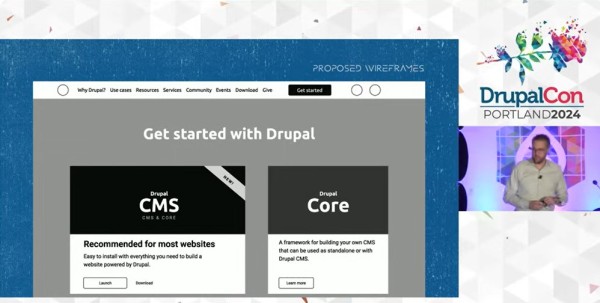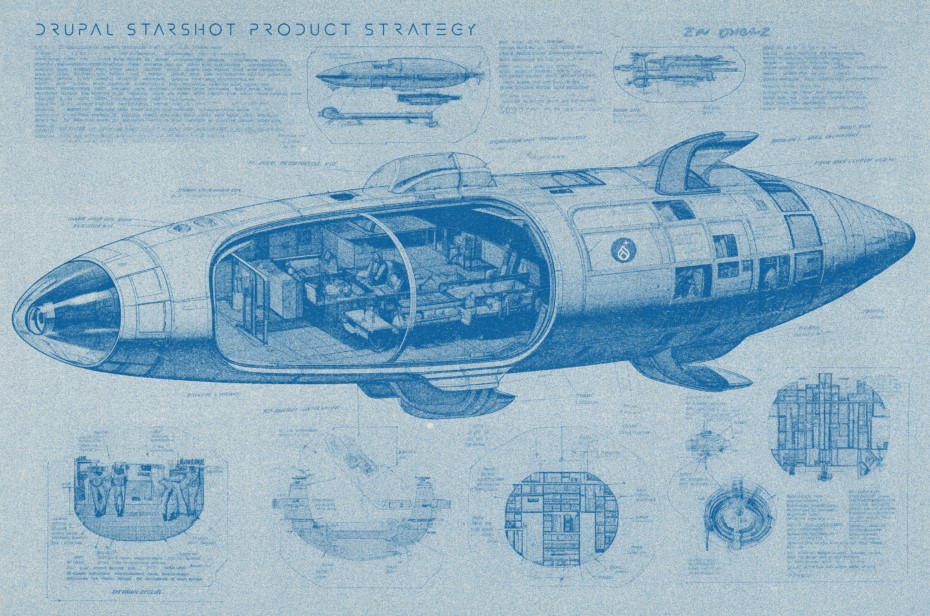When Dries Buytaert announced the game changing Starshot initiative for a marketer-friendly, no-code ‘out the box’ Drupal product in his May 2024 DrupalCon Portland Driesnote, some in the Drupal community were surprised. It was billed a “radical” departure from Drupal’s long-term trajectory as a developer-focused, enterprise scale CMS. Now with the Drupal Starshot product strategy live, what else do we know?
What is Drupal Starshot and why was it needed?
Drupal offers unmatched flexibility, accessibility, scalability and security letting large or complex organisations evolve their websites whatever their changing requirements. But it’s not geared to non-technical users used to the slick user interfaces and functionality provided by competitors like Wordpress, Wix and Shopify.
Drupal Starshot aims to solve that problem by packaging the best of Drupal’s enterprise CMS features into a more user-friendly, no-code, powerful website building tool for “ambitious site builders” and content marketers.
The Starshot product strategy envisages an MVP by late 2024, with the working name of 'Drupal CMS', that will let people easily and quickly launch brilliant digital experiences with powerful AI and Martech capabilities from a standard web browser.
This ‘Drupal CMS’ will become the default version of Drupal to ‘Launch’ new web projects. Removing a significant barrier to entry for non-technical users, which currently starts by prompting people to Download Drupal using php and composer!
The idea is that by Drupal showing its best face first, it will bring in new audiences - including those with more limited IT budgets and resources - into the Drupal ecosystem and cement its position in the incredibly competitive CMS marketplace. All the while still delivering on its mission for an open, secure accessible internet.
What Starshot features are included in the no-code box?
Because its capabilities are built on Drupal Core, the Starshot product 'Drupal CMS' will have everything Drupal 10 has and more. Effectively a no-code Drupal software wizard, offering its best features without the need for coding and complex configuration. In fact, several of these user-friendly Starshot modules, both stable and experimental, have already been integrated into Drupal 10.3 and will eventually be a part of Core Drupal 11 which launched in early August 2024.
Starshot’s Drupal CMS main features are:
- Recipes: pre-configured Drupal setups for common website needs, whether it’s a Recipe for a entire type of website like a blog or online store; content types like lead-gen forms, events listings, chat forums or image galleries, and more behind the scenes functionality like content governance and workflow rules. And all of which can be mixed and matched and further customised, if needed, once set up. Things that might have taken days to configure will be completed in just hours with the right Recipe. Recipes are also now supported in Drupal 10.3 and Drupal 11.

- Experience Builder: replacing the current Layout Builder, there will be a browser-based, highly intuitive user-interface based on React called Experience Builder that allows people with limited technical skills, bar some html basics, to create to create engaging, accessible and high-functioning web pages and content layouts.
Structured data and access controls will ensure content and design consistency to manage and reuse content across multiple channels at scale, including for headless CMS and DXP set ups. Content creators and product owners can also easily make large-scale design changes like rebranding, or do large-scale content imports, exports, and migrations. Experience Builder is actively being worked on as a contributed module.
- AI-powered tools: Dries’ Starshot product strategy went into further detail about how responsible AI might work as a game-changing opportunity to transform website and digital experience building in Drupal. It talked about AI-powered tools that simplify creating content types and other site elements and empowering all users, developers and non-developers alike to “cut implementation costs and time”, but always implemented in such a way that “humans will always have the final say”.

- Project Browser: while Drupal always ‘had an app for that’, finding the right components and modules isn’t easy. A hybrid advanced search engine and app store, Project Browser lets users to find and install necessary components directly from their browser, filtering modules based on needs and compatibility. Minimising the trial-and-error process of finding the right tools, and making setups more efficient. Project Browser is also part of Drupal 11.
- Automatic Updates: the least glamorous, but utterly critical chore of website management to keep sites secure and performant, updating Drupal required developer support, Starshot, instead will have automatic updates, providing site owners with piece of mind and saving time and budget. And likewise is being worked on in Drupal 11.
- Pre-Configured Modules for Seamless Setup: while being able to customise and configure everything is a huge strength of Drupal as an enterprise CMS, for more basic sites, certain things need to be a given for a quick and easy set-up. Dries’ Starshot product strategy talks about a huge range of pre-configured marketing-friendly modules and integrations including analytics tools, SEO tools like Semrush, as well as content scheduling features, improved admin interface and spam protection like ReCaptcha and far more besides.
Compared to other open-source CMS, Starshot's 'Drupal CMS' will be simply more powerful for marketers and web builders. Offering Drupal’s far greater enterprise CMS capabilities and over 46,000-plus integrations with tools including AI, personalisation and other advanced Martech functionality.
And compared to proprietary CMS, including other no-code web builders, it will do all of that and have innovation, security and accessibility and a major focus on AI capabilities powered by for free 100,000s of diverse experts: all without locking the website owner into expensive vendor contracts or, even worse locking in their data or content to the vendor too.
What does Drupal Starshot mean for Drupal as a whole?
Drupal Starshot's Drupal CMS product isn’t a fork in the road or separate version of Drupal. Instead, the projects work in parallel, with experimental modules and innovation flowing between the Starshot initiative and Drupal Core releases, as evidenced by the new features in Drupal 10.3 and ongoing development of Drupal 11.
In addition, since unnecessary modules will also be moved out of Core, and Recipes and contributions will do more of the heavy lifting, it will be leaner and allow for faster innovation.
What’s clear is the Starshot initiative is injecting a fantastic shot of User Experience (UX) design thinking into the Drupal ecosystem, which we fully welcome. It can only be a good thing to have involvement of marketers, website owners and content teams in the Drupal ecosystem. Client insights are critical to help ensure Drupal is fit for purpose in the coming years, particularly with the move towards headless CMS and DXP.
So, while Starshot's Drupal CMS promises to be no-code Drupal ‘out the box’, it’s actually also an opportunity to free up Drupal development experts like us to think and work outside the box, as it will help do some of the current heavy lifting in enterprise CMS projects.
It will let us devote more time – and more of any project budget - to unravelling complex user needs and business requirements to ensure our clients get exactly what they need from their digital ecosystems.
Find out about how we build Drupal sites to future-proof your enterprise digital strategy in our latest white paper: Why Migration to Drupal 10 and beyond should be your next CMS move.

